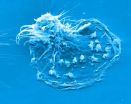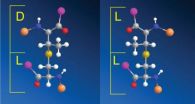(Press-News.org) When people wash their hands with antibacterial soap, most don't think about where the chemicals contained in that soap end up. University of Minnesota engineering researchers do.
A new University of Minnesota study determined that the common antibacterial agent, called triclosan, used in soaps and many other products is found in increasing amounts in several Minnesota freshwater lakes. The findings are directly linked to increased triclosan use over the past few decades.
In addition, the researchers found an increasing amount of other chemical compounds, called chlorinated triclosan derivatives, that form when triclosan is exposed to chlorine during the wastewater disinfection process. When exposed to sunlight, triclosan and its chlorinated derivatives form dioxins that have potential toxic effects in the environment. These dioxins were also found in the lakes.
The study was just accepted by the journal Environmental Science and Technology and is published online.
The study's results raise new questions about the use of triclosan. Triclosan was patented in 1964 and introduced into the market in the early 1970s. Since then it has been added to many consumer products including soaps and body washes, toothpastes, cosmetics, clothing, dishwashing liquid, and kitchenware. Beyond its use in toothpaste to prevent gingivitis, the U.S. Food and Drug Administration has found no evidence that triclosan in antibacterial soaps and body washes provide any benefit over washing with regular soap and water. The FDA and the Environmental Protection Agency continue to study the effects of triclosan on animal and environmental health.
"It's important for people to know that what they use in their house every day can have an impact in the environment far beyond their home," said the study's lead author William Arnold, a civil engineering professor in the University of Minnesota's College of Science and Engineering. "Consumers need to know that they may be using products with triclosan. People should read product labels to understand what they are buying."
Arnold said this research can also help chemical manufacturers understand some of the potential long-term impacts from triclosan on the environment.
The researchers studied the sediment of eight lakes of various size throughout Minnesota with varying amounts of treated wastewater input. They gathered sediment cores about one meter long from each of the lakes. After slicing the cores into several segments about two to four centimeters in thickness, they worked with researchers at the Science Museum of Minnesota's St. Croix Watershed Research Station to date the sediment. Some sediment segments dated back more than 100 years. Professor Arnold's group and researchers from Pace Analytical Services in Minneapolis used high tech methods to analyze the chemicals contained in the sediments over time.
The research found that sediment collected from large lakes with many wastewater sources had increased concentrations of triclosan, chlorinated triclosan derivatives, and triclosan-derived dioxins since the patent of triclosan in 1964. In small-scale lakes with a single wastewater source, the trends were directly attributed to increased triclosan use, local improvements in treatment, and changes in wastewater disinfection since the 1960s. When UV disinfection technology replaced chlorine in one of the wastewater treatment plants, the presence of chlorinated triclosan derivatives in the sediments decreased.
In the lake with no wastewater input, no triclosan or chlorinated triclosan derivatives were detected. Overall, concentrations of triclosan, chlorinated triclosan derivatives, and their dioxins were higher in small lakes, reflecting a greater degree of wastewater impact.
"The results were similar to other recent studies worldwide, but this was the first broad study that looked at several different lakes with various wastewater treatment inputs," Arnold said. "While wastewater treatment removes the vast majority of triclosan, these systems were not designed with this in mind. We need to continue to explore all aspects of this issue."
INFORMATION:
The lakes studied were Lake Pepin, Lake St. Croix, Lake Winona, East Lake Gemini, Lake Shagawa, Duluth Harbor, Lake Superior, and Little Wilson Lake. The research was funded by the Minnesota Environment and Natural Resources Trust Fund as recommended by the Legislative-Citizen Commission on Minnesota Resources. The National Science Foundation provided additional funds.
In addition to Arnold, the research team included University of Minnesota civil engineering graduate student Cale Anger; Charles Sueper, HRMS technical director at Pace Analytical Services Inc.; earth sciences graduate student Dylan Blumentritt; Kristopher McNeill, a professor from the Institute of Biogeochemistry and Pollutant Dynamics at ETH-Zurich, Switzerland and former University of Minnesota chemistry professor; and Daniel Engstrom, director of the St. Croix Watershed Research Station, Science Museum of Minnesota and adjunct professor of earth sciences at the University of Minnesota.
To read the full research paper, visit the Environmental Science and Technology website.
At the University of Minnesota, researchers are exploring lasting solutions to environmental challenges. These game-changing efforts are the impetus behind MnDRIVE, the university's proposal for a new, ongoing partnership with the state to enhance Discovery, Research, InnoVation and Economic development. For more information, visit www.govrelations.umn.edu/biennial-budget.html.
Antibacterial agent used in common soaps found in increasing amounts in freshwater lakes
University of Minnesota study raises new questions about use of triclosan
2013-01-22
ELSE PRESS RELEASES FROM THIS DATE:
Paradise found for Latin America's largest land mammal
2013-01-22
NEW YORK (January 22, 2012) —Wildlife Conservation Society scientists have documented a thriving population of lowland tapirs – the strange forest and grassland-dwelling herbivore with the trunk-like snout – living in a network of remote national parks spanning the Peru-Bolivia border.
Using a combination of camera traps, along with interviews with park guards and subsistence hunters, WCS estimates at least 14,500 lowland tapirs in the region. The population bridges five connected national parks in northwest Bolivia and southeastern Peru.
The WCS findings were described ...
Immune system molecule with hidden talents
2013-01-22
This press release is available in German.
Dendritic cells, or DCs for short, perform a vital role for the immune system: They engulf pathogens, break them down into their component parts, and then display the pieces on their surface. This in turn signals other immune cells capable of recognizing these pieces to help kick-start their own default program for fighting off the invaders. In order to do their job, the DCs are dependent upon the support from a class of immune system molecules, which have never before been associated with dendritic cells: antibodies, best ...
New research on military traumatic brain injury
2013-01-22
Philadelphia, Pa. (January 22, 2013) – Researchers are making new strides in understanding the health consequences and treatment and rehabilitation needs of combat veterans and other service members affected by traumatic brain injury (TBI). The January-February issue of The Journal of Head Trauma Rehabilitation, official journal of the Brain Injury Association of America, is a special issue devoted to new research in military TBI. The journal is published by Lippincott Williams & Wilkins, a part of Wolters Kluwer Health.
"For the second consecutive year, we've expedited ...
New information on binding gold particles over metal oxide surfaces
2013-01-22
The strong binding of gold on electronically modified calcium oxide can now be understood in detail. In a computational study, researchers Jenni Andersin, Janne Nevalaita, Karoliina Honkala and Hannu Häkkinen at the University of Jyväskylä Nanoscience Center have shown how redox chemistry entirely determines the adsorption strength of gold on the modified oxide where one metal atom is replaced with molybdenum. The study was funded by the Academy of Finland.
The research team applied the so-called Born-Haber cycle to analyse how different terms contribute to adsorption ...
The Nurse Practitioner marks 25th Annual Legislative Update
2013-01-22
Philadelphia, Pa. (January 22, 2013) – The most comprehensive review of new legal and regulatory issues affecting advanced nursing practice across the United States is now available in the "25th Annual Legislative Update," presented exclusively by The Nurse Practitioner: The American Journal of Primary Healthcare. The Nurse Practitioner is published by Lippincott Williams & Wilkins, a part of Wolters Kluwer Health.
Compiled by Susanne J. Phillips, MSN, FNP-BC, the annual supplement presents a comprehensive review of the legislative proceedings, bills, and laws pertaining ...
South Americans want policy makers to put ethics above price
2013-01-22
Researchers at Royal Holloway university have found that Brazilians and Chileans want the state to buy on social and environmental criteria, not just on price.
Based on this pioneering research, researchers from Royal Holloway have been invited to be the first academics to join the UN Environmental Programme's global Sustainable Public Procurement Initiative and attend its meeting in Paris this week.
The Choices Project is a collaboration between Royal Holloway, the Universidade Federal do Rio de Janeiro and Universidad Diego Portales. The project team also involves ...
Mayo Clinic expert suggests proper techniques for newborn bathing and skin care basics
2013-01-22
ROCHESTER, Minn. -- Bathing a tiny newborn can be an exciting experience for parents, but it can also be intimidating. Newborns are small and vulnerable, slippery when wet, and the products marketed for their delicate skin can leave parents with abundant choices. As newborns are welcomed into the world, their skin needs to adapt to the new environmental changes around them. It's important for parents to understand proper bathing techniques and the appropriate skin care needed for their little one.
Pediatric dermatologist Dawn Davis, M.D., of Mayo Clinic Children's Center ...
Study: Odd biochemistry yields lethal bacterial protein
2013-01-22
CHAMPAIGN, Ill. — While working out the structure of a cell-killing protein produced by some strains of the bacterium Enterococcus faecalis, researchers stumbled on a bit of unusual biochemistry. They found that a single enzyme helps form distinctly different, three-dimensional ring structures in the protein, one of which had never been observed before.
The new findings, reported in Nature Chemical Biology, should help scientists find new ways to target the enterococcal cytolysin protein, a "virulence factor that is associated with acute infection in humans," said University ...
Scientists find gene interactions that make cocaine abuse death 8 times more likely
2013-01-22
COLUMBUS, Ohio – Scientists have identified genetic circumstances under which common mutations on two genes interact in the presence of cocaine to produce a nearly eight-fold increased risk of death as a result of abusing the drug.
An estimated one in three whites who died of cocaine exposure is a carrier of variants that make cocaine abuse particularly deadly.
The variants are found in two genes that affect how dopamine modulates brain activity. Dopamine is a chemical messenger vital to the regular function of the central nervous system, and cocaine is known to block ...
Tiny fossils hold answers to big questions on climate change
2013-01-22
The western Antarctic Peninsula is one of the fastest warming regions on the planet, and the fastest warming part of the Southern Hemisphere.
Scientists have debated the causes of this warming, particularly in light of recent instrumental records of both atmospheric and oceanic warming from the region. As the atmosphere and ocean warm, so the ice sheet (holding an equivalent of 5 metres of global sea level rise, locked up in ice) becomes vulnerable to collapse.
Now research led by Cardiff University published in Nature Geoscience has used a unique 12,000 year long ...
LAST 30 PRESS RELEASES:
Scientists trace microplastics in fertilizer from fields to the beach
The Lancet Obstetrics, Gynecology, & Women’s Health: Taking paracetamol during pregnancy does not increase risk of autism, ADHD or intellectual disabilities, confirms new gold-standard evidence review
Taking paracetamol during pregnancy does not increase risk of autism, ADHD or intellectual disabilities
Harm reduction vending machines in New York State expand access to overdose treatment and drug test strips, UB studies confirm
University of Phoenix releases white paper on Credit for Prior Learning as a catalyst for internal mobility and retention
Canada losing track of salmon health as climate and industrial threats mount
Molecular sieve-confined Pt-FeOx catalysts achieve highly efficient reversible hydrogen cycle of methylcyclohexane-toluene
Investment in farm productivity tools key to reducing greenhouse gas
New review highlights electrochemical pathways to recover uranium from wastewater and seawater
Hidden pollutants in shale gas development raise environmental concerns, new review finds
Discarded cigarette butts transformed into high performance energy storage materials
Researchers highlight role of alternative RNA splicing in schizophrenia
NTU Singapore scientists find new way to disarm antibiotic-resistant bacteria and restore healing in chronic wounds
Research suggests nationwide racial bias in media reporting on gun violence
Revealing the cell’s nanocourier at work
Health impacts of nursing home staffing
Public views about opioid overdose and people with opioid use disorder
Age-related changes in sperm DNA may play a role in autism risk
Ambitious model fails to explain near-death experiences, experts say
Multifaceted effects of inward foreign direct investment on new venture creation
Exploring mutations that spontaneously switch on a key brain cell receptor
Two-step genome editing enables the creation of full-length humanized mouse models
Pusan National University researchers develop light-activated tissue adhesive patch for rapid, watertight neurosurgical sealing
Study finds so-called super agers tend to have at least two key genetic advantages
Brain stimulation device cleared for ADHD in the US is overall safe but ineffective
Scientists discover natural ‘brake’ that could stop harmful inflammation
Tougher solid electrolyte advances long-sought lithium metal batteries
Experts provide policy roadmap to reduce dementia risk
New 3D imaging system could address limitations of MRI, CT and ultrasound
First-in-human drug trial lowers high blood fats
[Press-News.org] Antibacterial agent used in common soaps found in increasing amounts in freshwater lakesUniversity of Minnesota study raises new questions about use of triclosan




